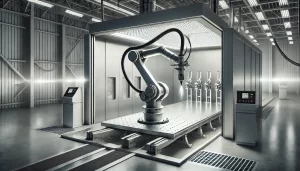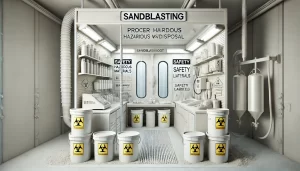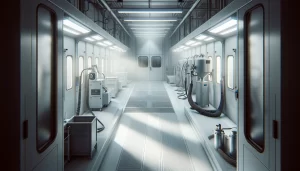Sandblasting booths are essential in many industries, from automotive refinishing to industrial metalwork. They provide a controlled environment for surface preparation, ensuring that parts and materials are properly cleaned and prepped for coatings or other treatments. But before investing in one, business owners need to understand not just the upfront purchase price but also the ongoing costs of operation. The total expense includes energy consumption, abrasive materials, equipment maintenance, labor, ventilation, and waste disposal. While these costs can vary based on factors like booth size, workload, and type of abrasives used, having a clear picture of what to expect can help you manage your budget effectively.
Energy Consumption and Utility Costs
One of the biggest expenses in running a sandblasting booth is energy consumption. Sandblasting equipment requires a high-powered air compressor to propel abrasives at high speed. The size of the compressor and the duration of operation significantly impact electricity costs. For instance, an industrial-grade compressor running continuously for several hours a day can consume a large amount of power, adding to your monthly utility bill.
The type of booth also plays a role. Some sandblasting booths are equipped with built-in lighting, ventilation systems, and dust collection units, all of which require electricity. If your facility runs multiple shifts or handles heavy workloads, expect your energy usage to be on the higher side. To reduce costs, consider using energy-efficient equipment or scheduling sandblasting tasks during non-peak hours when electricity rates may be lower.
Cost of Abrasive Media
Another ongoing expense is the cost of abrasive materials. Different types of abrasives, such as aluminum oxide, garnet, steel grit, and glass beads, vary in price. The choice of media depends on the material being blasted and the desired finish. Some abrasives, like steel grit, can be recycled multiple times, helping to reduce costs over time. Others, like silica sand or glass beads, may be single-use, leading to higher material consumption.
The frequency of media replenishment depends on usage and the effectiveness of the reclamation system in your booth. A well-designed recovery system can capture and reuse abrasives efficiently, minimizing waste and lowering replacement costs. However, if your operations involve heavy-duty sandblasting with high material consumption, the costs can add up quickly.
Equipment Maintenance and Repairs
Regular maintenance is necessary to keep a sandblasting booth running smoothly. Dust collectors, air compressors, nozzles, and filters require periodic cleaning and replacement. Over time, wear and tear on these components can lead to performance issues, resulting in inefficiencies or even costly downtime.
Nozzles, in particular, are subject to constant abrasion and need to be replaced frequently. A worn-out nozzle reduces blasting efficiency, increasing the time and energy required to complete a job. Keeping spare parts on hand and implementing a routine maintenance schedule can help prevent unexpected breakdowns and extend the lifespan of your equipment.
Another consideration is the cost of maintaining ventilation and dust collection systems. These systems prevent airborne particles from accumulating, improving air quality and worker safety. Filters must be cleaned or replaced regularly, and the entire system should be inspected to ensure proper functioning. Neglecting maintenance can lead to clogged filters, reduced airflow, and compliance issues with workplace safety regulations.
Labor Costs and Productivity
Labor is a significant factor in operating costs, as sandblasting requires skilled operators to handle equipment, prepare surfaces, and ensure proper application techniques. The cost of labor depends on wage rates in your region and the level of expertise required for the job. Training employees to use sandblasting equipment safely and efficiently can improve productivity and reduce material waste.
Automated or semi-automated sandblasting systems can help cut labor costs by reducing manual effort. While these systems require an initial investment, they can increase efficiency and consistency, ultimately leading to lower operational costs. However, even with automation, you’ll still need personnel for equipment monitoring, maintenance, and quality control.
Ventilation and Dust Collection Expenses
A proper ventilation system is crucial for maintaining a safe working environment. Sandblasting produces fine dust and airborne particles that can pose health risks if inhaled. Investing in a high-quality dust collection system helps minimize exposure and ensures compliance with occupational safety regulations.
The cost of running a dust collection system includes energy consumption, filter replacements, and periodic maintenance. Larger booths or those handling high-abrasive loads may require more powerful ventilation systems, leading to increased operational costs. Some facilities also require additional air treatment solutions, such as air scrubbers or HEPA filtration, to meet environmental standards.
Waste Disposal and Environmental Compliance
Disposing of spent abrasive material and dust is another expense to consider. Certain abrasives, especially those containing hazardous materials, must be disposed of according to local environmental regulations. This may involve paying disposal fees or working with waste management services to ensure proper handling.
Using recyclable abrasives can help reduce waste disposal costs. Many modern sandblasting booths come equipped with media reclamation systems that separate reusable abrasives from dust and debris. By optimizing media recovery, businesses can minimize waste and lower their overall environmental impact.
Compliance with environmental regulations is also important. Some jurisdictions have strict rules regarding airborne emissions, water runoff, and hazardous material handling. Failing to comply with these regulations can result in fines, additional permit costs, or legal liabilities. Investing in proper containment and filtration systems can help ensure compliance and avoid unexpected expenses.
How to Optimize Costs and Improve Efficiency
While sandblasting booths come with various operational expenses, there are ways to optimize costs and improve efficiency. Choosing the right abrasive material for your application, maintaining equipment regularly, and investing in energy-efficient systems can all help reduce expenses. Proper training for operators and implementing automation where possible can further improve productivity and minimize labor costs.
A well-designed sandblasting booth with an effective reclamation and dust collection system can significantly lower material waste and energy consumption. Businesses should also explore bulk purchasing options for abrasives and spare parts to take advantage of cost savings.
Specialized Sandblasting Booth Services
We specialize in providing top-quality sandblasting booths and custom finishing solutions tailored to meet the unique needs of various industries. Our expert team designs and manufactures state-of-the-art sandblasting booths that ensure safety, efficiency, and superior performance. From automotive and aerospace to marine and industrial applications, our booths are engineered to handle even the most demanding surface preparation tasks. We offer comprehensive services, including booth installation, maintenance, upgrades, and technical support.




